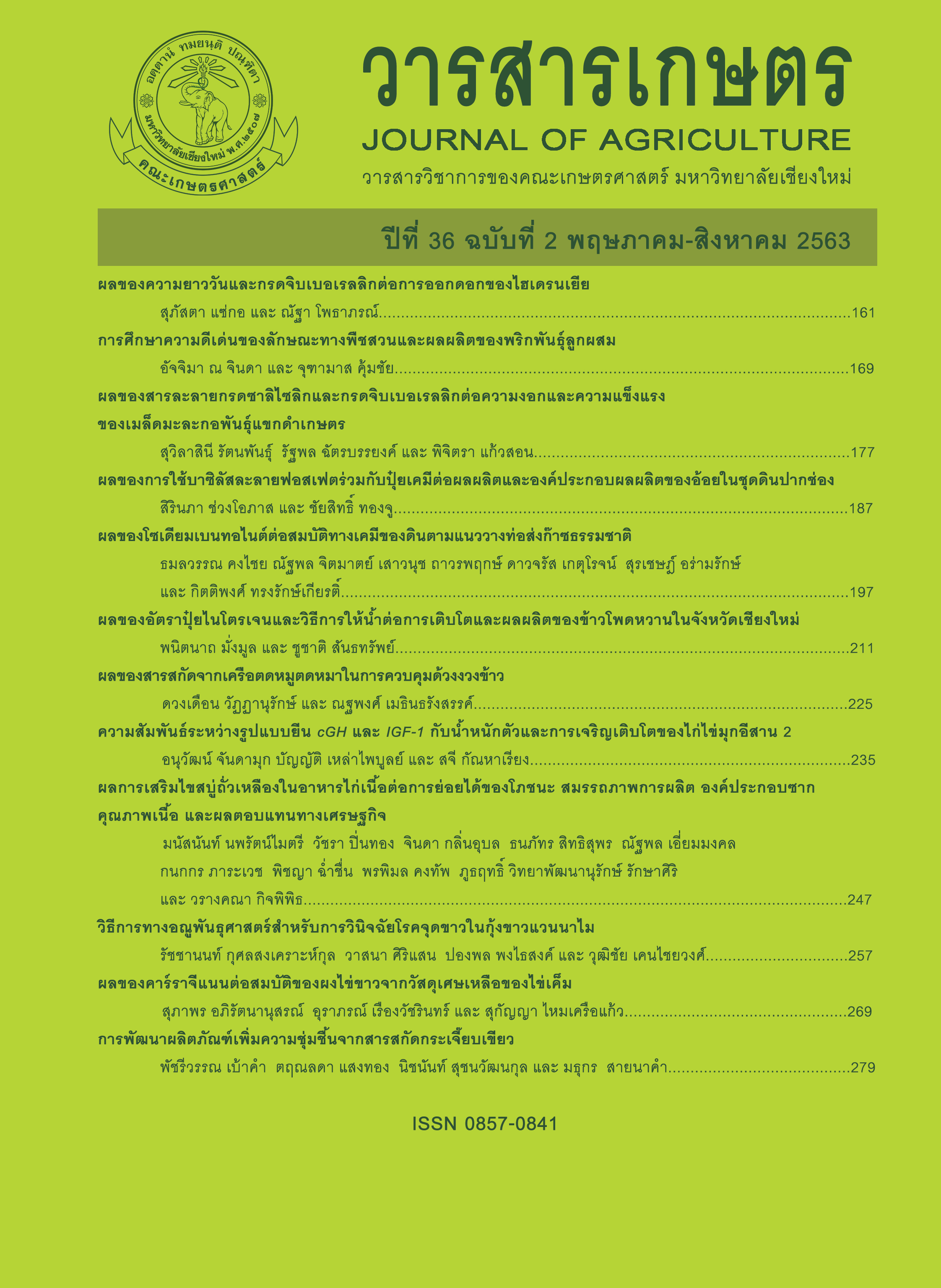ผลของการใช้บาซิลัสละลายฟอสเฟตร่วมกับปุ๋ยเคมีต่อผลผลิตและองค์ประกอบผลผลิตของอ้อยในชุดดินปากช่อง
Main Article Content
บทคัดย่อ
วัตถุประสงค์ของงานวิจัยนี้เพื่อศึกษาการละลายฟอสเฟตและการชะล้างของแบคทีเรียเมื่อใส่ปุ๋ยชีวภาพพีเอสบี (phosphate-solubilizing bacteria biofertilizer) ในชุดดินปากช่อง และศึกษาผลของการใช้ปุ๋ยชีวภาพพีเอสบีร่วมกับปุ๋ยเคมีในการปลูกอ้อย โดยแบ่งการศึกษาออกเป็น 2 การทดลอง การทดลองที่ 1 เป็นการศึกษาผลของการใช้ปุ๋ยชีวภาพพีเอสบีต่อการละลายฟอสเฟตในชุดดินปากช่อง โดยวางแผนการทดลองแบบสุ่มสมบูรณ์ จำนวน 3 ซ้ำ และ 7 ตำรับการทดลอง ที่มีการใช้ปุ๋ยชีวภาพพีบีเอสที่แตกต่างกัน 7 อัตรา (2 - 64 กรัมต่อกิโลกรัมดิน) ตรวจสอบปริมาณฟอสฟอรัสที่เป็นประโยชน์ และจำนวนของแบคทีเรียในน้ำที่ชะล้างผ่านคอลัมน์ดิน ในระยะเวลา 90 วัน ผลการศึกษาพบว่าชุดดินปากช่องที่ใส่ปุ๋ยชีวภาพพีเอสบี อัตรา 64 กรัมต่อกิโลกรัมดิน มีปริมาณฟอสฟอรัสที่เป็นประโยชน์ในน้ำชะล้างสูงสุดเท่ากับ 31.10 มิลลิกรัมต่อลิตร และแม้ว่าจะมีการชะล้างด้วยน้ำอย่างต่อเนื่องแต่ยังพบว่ามีปริมาณฟอสฟอรัสที่เป็นประโยชน์สูง ชี้ให้เห็นว่าแบคทีเรียยังคงมีการทำกิจกรรมการละลายฟอสเฟตและมีการอยู่รอดในดิน สำหรับการทดลองที่ 2 วางแผนการทดลองแบบสุ่มสมบูรณ์ ในการศึกษาผลของการใช้ปุ๋ยชีวภาพพีเอสบีร่วมกับปุ๋ยเคมีต่อผลผลิตและองค์ประกอบผลผลิตของอ้อยพันธุ์ลำปางที่ปลูกในกระถาง ทำการทดลอง 9 ตำรับ 3 ซ้ำ ผลการศึกษาพบว่าการใส่ปุ๋ยชีวภาพพีเอสบี ร่วมกับการใช้ปุ๋ยเคมีตามค่าวิเคราะห์ดินทำให้ผลผลิตและองค์ประกอบผลผลิตของอ้อยที่ปลูกในชุดดินปากช่องมีผลผลิตเพิ่มขึ้นตามอัตราการใช้ปุ๋ยชีวภาพพีเอสบีที่เพิ่มขึ้น และอ้อยมีผลผลิตสูงสุดเมื่อใส่ปุ๋ยเคมี 15-7.5-15 กิโลกรัมต่อไร่ร่วมกับปุ๋ยชีวภาพพีเอสบีอัตรา 36 กิโลกรัมต่อไร่ ดังนั้นจึงแนะนำให้ใช้ปุ๋ยชีวภาพพีเอสบีในการละลายฟอสเฟตเพื่อส่งเสริมผลผลิตและองค์ประกอบผลผลิตของอ้อย ที่ปลูกในดินที่มีปริมาณฟอสฟอรัสที่เป็นประโยชน์ต่ำ เช่นชุดดินปากช่องได้
Article Details
เอกสารอ้างอิง
Agricultural Land Reform Office. 2019. Study on biofertilizerion and technical efficiency of sugarcane biofertilizerion of farmers in Khon Kaen province. (Online). Available: https://www.alro.go.th/research_plan/ article_attach/article_attach_201609051473069346.doc (July 8, 2019). (in Thai)
Alori, E.T., B.R. Glick and O.O. Babalola. 2017. Microbial phosphorus solubilization and its potential for use in sustainable agriculture. Frontiers in Microbiology 8: 971, doi: 10.3389/fmicb.2017.00971.
Bray, R.H. and N. Kurtz. 1945. Determination of total organic and available forms of phosphorus in soil. Soil Science 59: 39-45.
Department of Agriculture. 2010. Recommendations for using fertilizers with economic crops. Academic documents no. 8/2005. Department of Agriculture, Bangkok. (in Thai)
Department of Soil Science. 2011. Laboratory Manual for Soil Science. Department of Soil Science, Faculty of Agriculture, Kasetsart University, Bangkok. 207 p. (in Thai)
FAO Project Staff and Land Classification Division. 1973. Soil Interpretation Handbook for Thailand. Department of Land Development, Bangkok.
Hunsigi, G. 1993. Production of Sugarcane: Theory and Practice. Springer-Verlag, Berlin.
Jeenyew, W., C. Thongjoo, S. Amkha, T. Pornprom and S. Bootpetch. 2013. Utilization of waste materials from ethanol factory for increasing yield of sugarcane (Saccharum officinarum L.), pp. 86-99. In: Proceedings of the 10th National KU-KPS Conference, Nakhon Pathom. (in Thai)
Kanamnuay, N. 2007. Diversity and efficiency of Bacillus sp. on inorganic phosphate solubilization. M.S. Thesis. Kasetsart University, Bangkok. 76 p. (in Thai)
Kang, S.M., R. Radhakrishnan, Y.H. You, G.J. Joo, I.J. Lee, K.E. Lee and J.H. Kim. 2014. Phosphate solubilizing Bacillus megaterium mj1212 regulates endogenous plant carbohydrates and amino acids contents to promote mustard plant growth. Indian Journal of Microbiology 54(4): 427-433.
Mala, T. 2007. Organic Fertilizers and Biofertilizers: Biofertilizerion Techniques and Use. 2nd ed. Kasetsart University Press, Bangkok. 300 p. (in Thai)
Mala, T., S. Chungopast, K. Sinma, C. Hongprayoon and W. Phungsang. 2018. Soil Microbiology Laboratory. Department of Soil Science, Faculty of Agriculture at Kamphaeng Saen, Kasetsart University, Kamphaeng Saen Campus, Nakhon Pathom. 44 p. (in Thai)
Martínez, M. and A. Martínez. 2007. Effects of phosphate-solubilizing bacteria during the rooting period of sugar cane (Saccharum officinarum), Venezuela 51-71 variety, on the grower’s oasis substrate. pp. 317-323. In: E. Velázquez and C. Rodríguez-Barrueco (eds.). First International Meeting on Microbial Phosphate Solubilization. Springer, Dordrecht.
Martinez-Viveros, O., M. A. Jorquera, D.E. Crowley, G. Gajardo and M.L. Mora. 2010. Mechanisms and practical considerations involved in plant growth promotion by rhizobacteria. Journal of Soil Science and Plant Nutrition 10(3): 293-319.
Mengead, Y. 2019. Effect of chemical fertilizer management in combination with boron on yield of first ratoon cane planted in Kamphaeng Saen series. M.S. Thesis. Kasetsart University, Bangkok. (in Thai)
Office of soil Resources Survey and Research. 2019. Soil series properties and characteristics of the north east. (Online). Available: http://www.ldd.go.th/thaisoils_museum/pf_desc/northeast/Pc.htm (July 8, 2019). (in Thai)
Office of the Cane and Sugar Board. 2017. Report of the annual sugarcane planting area survey 2016/17. (Online). Available: http://www.ocsb.go.th/upload/journal/fileupload/923-9999.pdf (July 8, 2019). (in Thai)
Pratt, P.F. 1965. Potassium. pp. 1022-1030. In: C.A. Black, D.D. Evans, L.E. Ensminger, J.L. White and F.E. Clark (eds.). Method of Soil Analysis. Part 2. American Society of Agronomy Inc., Madison, Wisconsin.
Pumpuang, P., C. Thongjoo, T. Mala, S. Amkha, W. Thaymuang, C. Khongsud, T. Klumchaun, P. Katpiyarat and S. Bootpetch. 2014. Efficient of using different forms of urea on growth and yield components of sugarcane. pp. 11-13. In: Proceedings of 11th Kasetsart University Kamphaeng Saen Campus Conference: Plant and Biotechnology, Nakhon Pathom. (in Thai)
Rodríguez, H. and R. Fraga. 1999. Phosphate solubilizing bacteria and their role in plant growth promotion. Biotechnology Advances 17: 319-339.
Saeid, A., E. Prochownik and J. Dobrowolska-Iwanek. 2018. Phosphorus solubilization by Bacillus species. Molecules 23(11): 2897, doi: 10.3390/molecules23112897.
Sharma, S.B., R.Z. Sayyed, M.H. Trivedi and T.A. Gobi. 2013. Phosphate solubilizing microbes: sustainable approach for managing phosphorus deficiency in agricultural soils. SpringerPlus 2: 587, doi: 10.1186/2193-1801-2-587.
Sundara, B., V. Natarajan and K. Hari. 2002. Influence of phosphorus solubilizing bacteria on the changes in soil available phosphorus and sugarcane and sugar yields. Field Crops Research 77(1): 43-49.
The Secretariat of the Cabinet. 2009. Ministry of Agriculture and Cooperatives Announcement: Determine the error of the quantity of microorganisms certified. Follow by Fertilizer Act B.E. 1975 Amended by Fertilizer Act (No. 2) B.E. 2007. Government Gazette 126(63): 65 (in Thai)
Walkley, A. and C.A. Black. 1934. An examination of degtjareff method for determining soil organic matter and proposed modification of the chromic acid titration method. Soil Science 37: 29-35.
White, R.E. 2003. Soils for Fine Wines. Oxford University Press, New York. 312 p.


